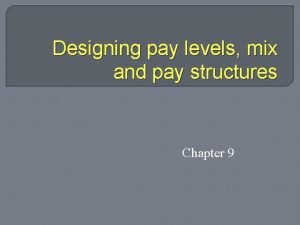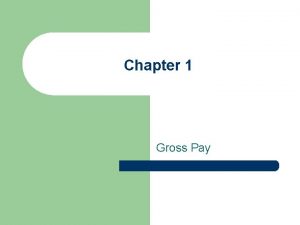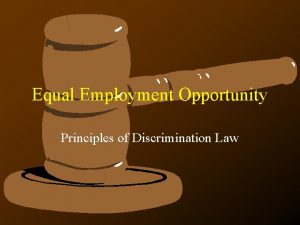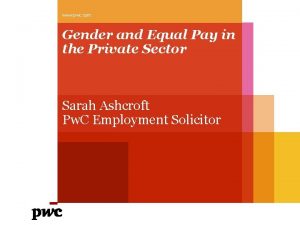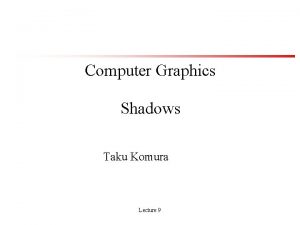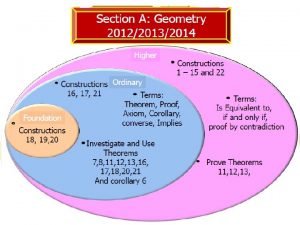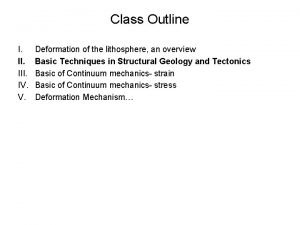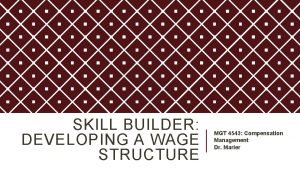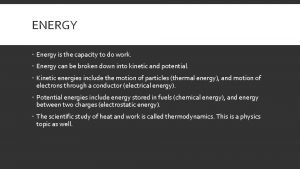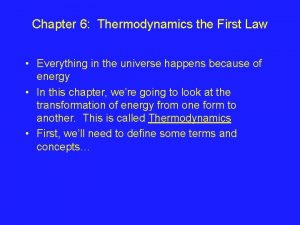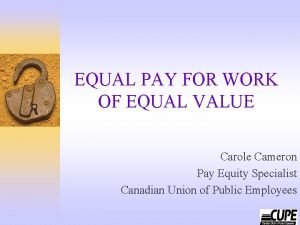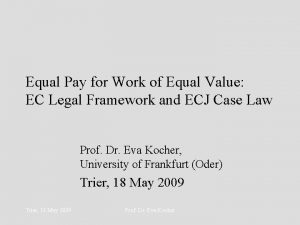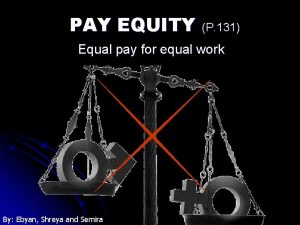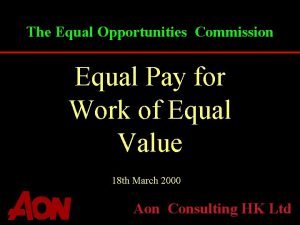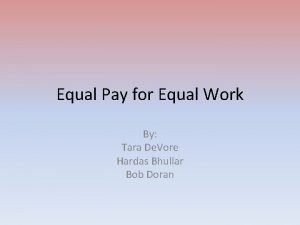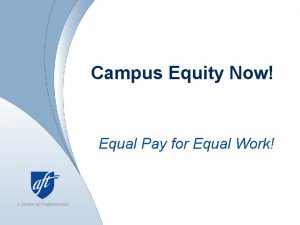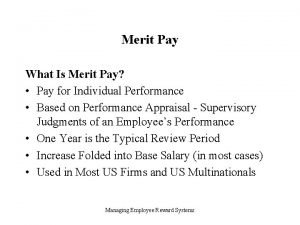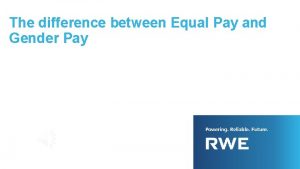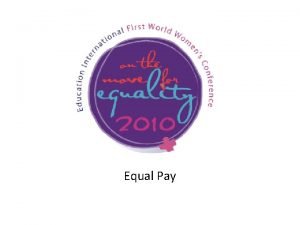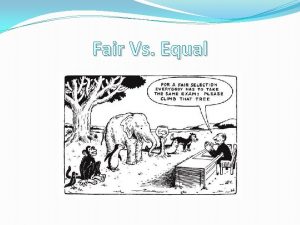EQUAL PAY FOR WORK OF EQUAL VALUE CAPACITY





























- Slides: 29

EQUAL PAY FOR WORK OF EQUAL VALUE CAPACITY BUILDING FORUM

COPYRIGHT Unless otherwise indicated, copyright in this material vests in the Commission for Conciliation, Mediation and Arbitration. No part of this material may be reproduced, modified or adapted in any form or by any means without the written permission of the Commission for Conciliation, Mediation and Arbitration.

Purpose of the Presentation The presentation serves to enhance the knowledge and understanding of participants regarding the following – q Grounds for a claim of equal pay for work of equal value; q Application of the test for unfair discrimination in a claim of equal pay for work of equal value; q The jurisdiction of the CCMA in determining such disputes; q Assessing if work is same, similar or of equal value; and q What remedies may be awarded for such disputes.

Section 6 (1) & (4) of the EEA – Unfair Discrimination related to Work of Equal Value Section 6(1) of the EEA is amended to add to the listed grounds that unfair discrimination is also prohibited “on any arbitrary ground”. Section 6(4) of the EEA is added: “ A difference in terms and conditions of employment between employees of the same employer performing the same or substantially the same work or work of equal value that is directly or indirectly based on one or more of the grounds listed in subsection (1) is unfair discrimination”. ILO Convention 111: “Any distinction, exclusion or preference on various grounds” which has the effect of nullifying or impairing equality of opportunity or treatment in employment or occupation”. ILO Convention 100 – Equal Pay – specifically deals with the principle of equal remuneration for men and women. The EEA is now aligned with this Convention and specifically provides that unfair discrimination in respect of remuneration and other conditions of employment can be brought in terms of section 6 of the EEA.

Section 6 (1) & (4) of the EEA – Unfair Discrimination related to Work of Equal Value Listed Grounds – q Race, gender, sex, pregnancy, marital status, family responsibility, ethnic or social origin, colour, sexual orientation, age, disability, religion, HIV status, conscience, belief, political opinion, culture, language or birth. Unlisted or Analogues Grounds = Arbitrary Grounds – q Based on attributes and characteristics which have the potential to impair the fundamental human dignity or persons as human beings or to affect them adversely in a comparably serious manner, the focus being on the impact on the complainant and others in his/her situation. Meaning of “Arbitrary Grounds – q As held in Pioneer Foods (Pty) Ltd v Workers Against Regression (WAR) & Others (2016) ZALCCT 14. q Thus, differentiation based on any ground will amount to unfair discrimination unless the employer can show differentiation is based on fair criteria such as experience, skill, responsibility, etc. q Section 6(5) of the EEA informs that the Minister, after consultation with the Commission for Employment Equity, may prescribe criteria and methodology for assessing work of equal value.

Section 6 (1) & (4) of the EEA – Unfair Discrimination related to Work of Equal Value Even prior to the amendments under section 6(1) and 6(4) of the EEA, the Courts have recognised “listed” “prohibited” “unlisted” “arbitrary” grounds; and recognised that pay or remuneration is and employment policy or practice and that it was possible to make a case of unfair discrimination where pay differentials were based on a prohibited ground. Therefore, the amendments rather clarified than make our present law.

What needs to be established? The worker needs to show – q That there is a differentiation in remuneration between worker A and worker B for same or similar work done. q That both workers are working for the same employer. q That there is sufficient proof to suggest that the difference in pay links to a ground for discrimination (whether listed or arbitrary). The employer, against whom the claim is made, must prove – q There was no discrimination, or q The discrimination is rational and not unfair, or otherwise justifiable. ** The employer therefore retains the right to reward employees unequally but the differentiation must be rational and objective.

Remuneration & Benefits Section 21(1) of the EEA – q A designated employer is required to submit a report concerning its Employment Equity Plan to the Director General on an annual basis. q The report must be accompanied by a statement on the remuneration and benefits received in each occupational level of that employer’s workforce (section 27). Section 27(2) of the EEA – q Requires a designated employer to take measures to progressively reduce differences in terms and conditions of employment as contemplated in section 6(4) of the EEA.

Meaning of Work of Equal Value For the purposes of the Regulations, the work performed by the employee – q Is the same as the work of another employee of the same employer if their work is identical or interchangeable. q Is substantially the same as the work of another employee employed by the employer, if the work is sufficiently similar to the extent to which they can reasonably be considered to be performing the same job-even of the work is not identical or interchangeable. q Is of the same value as the work of another employee of some employer in a different job, if their respective work is given the same value after proper assessment.

Assessing Work of Equal Value Regulation 4 – q In considering whether work is of equal value, relevant jobs must be objectively assessed taking into account the following criteria: § Responsibility, including prior learning and experience required to perform the work § Effort, physical, mental and emotional § Working conditions, including physical environment, psychological conditions, time when and geographical location where the work is performed. In addition – q Any relevant factor indicating the value of work may be considered. q The assessment must be conducted in a manner free from bias, on grounds of race, gender or disability or any other listed or arbitrary ground (section 6(1)). q An employer must justify the value assigned to an employee’s work by referring to the classification of a relevant job in terms of a sectoral determination.

Some Causes of Wage Gaps Individual characteristics – q Lack of education. q Lack of work experience. Residual characteristics – q Stereotypes and prejudice (bias). q Traditional methods of job evaluation. q Weaker bargaining power. ILO Approach – q Improvement in human resources practices. q Highlighting the undervalued skills of female workers. q Better perception of workplace equity and improved relations. q Impacts on the organisation’s reputation and attractiveness.

Assessing Work of Equal Value Assessing Different Jobs Conducting a Planned & Structured Process The Regulation list Four Factors: Pay equity is achieved through a process which involves: § Qualification, skills, prior learning and experience required for the job. § Responsibility demanded of the job. § Physical, mental and emotional effort required to perform the work. § The conditions under which work is performed including the physical environment, geographical location, time when work is to be performed, etc. § Identifying jobs to be compared, § Choosing a job evaluation method, § Developing tools for gathering data on the jobs, § Analysing the questionnaire results, § Determining the value of jobs, § Estimating wage gaps between jobs of equal value, and § Making pay adjustments to achieve pay equity.

Important! Questions to Consider IS THE WORK OF EQUAL VALUE? IS THERE A DIFFERENCE IN TERMS & CONDITIONS OF EMPLOYMENT, INCL. REMUNERATION? WHAT IS THE ALLEGED FROUND FOR DISCRIMINATION? DOES THE DIFFERENTIATION AMOUNT TO DISCRIMINATION AND IN THE DISCRIMINATION FAIR? WHAT IS THE REMEDY? IS THE DISCRIMINATION DIRECT OR INDIRECT? Impact?

Doctrine of Substantive Equality It is not discriminatory to differentiate between employees in order to place them in a similar position.

Length of Service as an Arbitrary Ground In Pioneer Foods the Court held that there is nothing arbitrary or irrational about the uniform application of a rule which sets different pay levels for employees with different lengths of service. The same will apply if the newly recruited employee has the same level of experience and expertise as the employer’s existing long-service employees. Ntai & Others v South African Breweries Ltd (2001) 2 BLLR 186 (LC) the Labour Court held that it was accepted seniority and length of service as justifications for differential treatment. The differentiation in pay is not sufficient; it still has to be linked to a unacceptable ground for it be discrimination.

Employment Policy or Practice It includes but is not limited to – q Recruitment procedures, advertising and selection criteria. q Appointments and the appointment process. q Job classification and grading. q Remuneration, employment benefits and terms & conditions of employment. q Job assignments. q The job environment and facilities. q Training and development. q Performance evaluation systems. q Promotion, transfer, demotion, disciplinary measures and dismissals. Other factors to be considered – q Justifications, geographical location, Skills (Shortage of Skill), Ability to Bargain. q General fairness defence - Mbana v Shepstone and Wylie [2015] ZACC 11 in which the Court held that “the business needs of the employer” can be accepted as a defence.

Applying the TEST for Unfair Discrimination in Equal Pay Cases Harksen v Lane (Harksen v Lane NO and Others 1998 (1) SA 300 (CC) Test – 1. Has there been differentiation between people, or categories of people? 2. If so, does that differentiation amount to discrimination? q It will be discrimination if the differentiation is q On a listed ground q On a arbitrary ground 3. If so, is the discrimination unfair? q If the discrimination is on a listed ground, it is presumed to be unfair (placing the onus on the employer to justify it), q If not on a listed ground, the complainant must prove that the ground of discrimination is an arbitrary ground. 4. What the Labour Court has said (Mangena & Others v Fila South Africa (Pty) Ltd & Others [2009] 12 BLLR 1224 (LC)) – q The applicant must provide facts to show: (a) there is a difference in pay between him or her and the comparator (b) the comparator does the same work, or work of equal value, and (c) the difference in pay is based on an arbitrary ground.

Mangena & Others v Fila South Africa (Pty) Ltd & Others “. . it is not an unfair labour practice to pay different wages for equal work for work of equal value. It is however an unfair labour practice to pay different wages for equal work for work of equal value if the reason or motive, being the cause for so doing, is direct or indirect discrimination on arbitrary grounds or listed grounds, e. g. race or ethnic origin. . . ” (Louw v Golden Arrow Bus Services (Pty) Ltd (2000) 21 ILJ 188 (LC) q In other words, one must establish a link between the pay differential, and a listed or arbitrary ground, in order to shift the burden onto the employer to show that the discrimination is not unfair. q Pay differentials are, therefore, per se not unfair; it is unfair once the differentiation amounts to unfair discrimination.

Applying the TEST for Unfair Discrimination in Equal Pay Cases Ø Direct Pay Discrimination Indirect Pay Discrimination Direct discrimination is where the discriminatory treatment directly impacts on a person’s right to dignity, on either a listed or an unlisted ground. Indirect discrimination is where a rule or employment practice or policy appears neutral, but has an adverse impact on individuals or groups of people. For example: the practice is that black African workers are paid less than white workers. The discrimination against is direct. For example: The rule is that workers woth unbroken service are paid more than workers with broken service. The rule appears neutral, but the impact is very different. Far more women than men are likely to have broken service because of pregnancy, maternity leave. Hence, the discrimination against women is indirect.

Jurisdiction in Unequal Pay Claims Section 10 of the EEA provides that “an employee may refer a dispute to the CCMA for arbitration if the employee alleges sexual harassment; or in any other case, if that employee earns less than the amount stated in the Ministerial Determination made in terms of section 6(3) of the BCEA (“the BCEA threshold”; R 205 433. 30). This means that an employee who earns under the BCEA threshold may elect to refer an unfair discrimination dispute to CCMA arbitration. However, where sexual harassment is alleged, all employees (including those who earn above threshold) may elect to refer the matter to CCMA arbitration. The CCMA may also arbitrate an unfair discrimination dispute if all the Parties consent to arbitration.

Dispute Resolution EEA disputes exclude dismissal disputes Act or omission to have occurred within six months of referral. Applicant to show (ito the 7. 11 Referral): Proof of service (now includes email) There was a reasonable attempt to resolve If matter remains unresolved, applicant may apply to Labour Court within three months of the conciliation (if applicant is above threshold). Parties may also consent to arbitration (if applicant is above threshold).

Important! Reasonable Attempt to Resolve The claimant must first attempt to resolve the dispute internally; This ensures that the claimant alerts the employer to the claim and the employer attempts to resolve the matter.

Right to Appeal and Right to Review RIGHT TO APPEAL Section 10(8) of the EEA – q Any person affected by an award may appeal to the Labour Court within 14 days of the date of the award, which may be condoned on good cause shown. q This refers to those employees earning less than the threshold and referring unfair discrimination on the grounds of sexual harassment cases or any other case. q The merits of the matter may be reconsidered by the Labour Court on appeal if the party is dissatisfied with the outcome of the arbitration process. q For employees earning less than the threshold, they have a choice between CCMA arbitration and the Labour Court. RIGHT TO REVIEW Review is generally an allegation of a defect in the Commissioner’s conduct or procedure as defined in section 142(2) of the LRA. Appeal informs that the award is wrong on the facts. Appeal therefore opens the doors for grounds beyond section 145(2) of the LRA, and means that the award is not necessarily a final and binding one, as in the case of other arbitrations.

Remedies ito Section 48 of the EEA – q Any appropriate Award that gives effect to the provisions of the EEA. q Award can include compensation, damages (not more than threshold) and directives. Remedies ito Section 50 of the EEA – q Compensation, damages, fines, directives and publications. Compensation v damages – q Compensation: Is awarded for the statutory right and is non=patrimonial. q Damages: Address patrimonial loss, proof must be submitted for the claim. It may include pain and suffering. **Hoffmann v SAA [2000] 12 BLLR 1365 (CC) the Court held that the remedy for unfair discrimination should be “not only the elimination of the discriminatory employment practice, but also that the person who has suffered a wrong as a result of unlawful discrimination be, as far as possible, restored to the position in which he or she would have been but for the unfair discrimination”.

Compensation to be Awarded How much compensation must be Awarded? q The following interests of both Parties must be considered – * the need to redress the wrong caused by the infringement, * deterrence of any future violations, * dispensation of justice which is fair to all affected, and * the necessity of ensuring that the order can be complied with. Just and equitable compensation? q Decision makers will consider – * the nature and seriousness of the iniuria, * the circumstances under which the infringement took place, * the behaviour of the respondent, especially, whether the motive was honourable or malicious, * the extent of the humiliation or distress suffered by the employee/s, * the abuse of the relationship between the parties, and * the attitude of the respondent after the iniuria.

Case Law on Equal Pay for Work of Equal Value (in Principle) Sethole and Others v Dr Kenneth Kaunda District Municipality (JSS 76/13) in which the Court held the enquiry into whether differentiation constitutes unfair discrimination is a three level enquiry. The three level enquiry seeking to establish whether differentiation constitutes unfair discrimination starts of by determining whether the differentiation that exists is of the kind that could give rise to a case of discrimination. In short, and even if there is differentiation, it does not mean that such differentiation per se would violate the right to equality. Ndudula v Metrorail Prasa (Western Cape) [2017] BLLR 706 (LC) the Court had to determine whether an error which resulted in newly employed employees being paid more than longer serving employees amounts to an arbitrary ground. The court noted that the complainants failed to identify any ground, and instead simply wanted to rely on the employer’s error. It was held that parliament did not introduce a third category of grounds upon which employees could challenge the conduct of employers.

Case Law on Equal Pay for Work of Equal Value (in Principle) UNADEWO v Cape Pine (Pty) Ltd t/a MTO Forestry (Unreported WEGE 787 -15/12/2015) in which the Commissioner found the Applicant had failed to identify the actual arbitrary ground on which his claims is based. Considering it was for the applicant to show that discrimination had taken place on an arbitrary ground, it was found that a mere arbitrary decision or action was not enough to prove unfair discrimination. Likewise to qualify as an arbitrary ground, there had to be a ground on which it was alleged that discrimination took place, and that ground had the effect of affecting the dignity of the employees in a comparably serious manner. Even if there had been discrimination, this was not unfair because the employer could justify the discrimination on the ground that the remuneration strategy that it had implemented, after consulting remuneration specialists and a majority union, permitted longer serving employees to be paid more.

Additional Readings Equal Remuneration Convention, 1951 (No. 100) Convention concerning Discrimination in Respect of Employment and Occupation, 1958 (No. 111)

THE END THANK YOU
 I work all night i work all day to pay the bills
I work all night i work all day to pay the bills How much did wanda pay in taxes this pay period
How much did wanda pay in taxes this pay period Designing pay levels
Designing pay levels Merit pay vs incentive pay
Merit pay vs incentive pay Graduated commission examples
Graduated commission examples Contoh value creation adalah
Contoh value creation adalah Production units have an optimal rate of output where:
Production units have an optimal rate of output where: Mass equal pay act
Mass equal pay act Equal pay act 1963 summary
Equal pay act 1963 summary Pwc equal pay
Pwc equal pay Equal height equal light
Equal height equal light Taku graphics
Taku graphics Equal sharing or grouping is called
Equal sharing or grouping is called What are opposite angles
What are opposite angles Equal area vs equal angle stereonet
Equal area vs equal angle stereonet How do pay grades work
How do pay grades work Salary range spread calculation
Salary range spread calculation What should be given attention in this style
What should be given attention in this style The gross pressure intensity q of a structure is
The gross pressure intensity q of a structure is It is the capacity to do work
It is the capacity to do work Capacity to do work is called
Capacity to do work is called Constant volume calorimeter
Constant volume calorimeter Energeia
Energeia Energy is the capacity to do work.
Energy is the capacity to do work. Fspos vägledning för kontinuitetshantering
Fspos vägledning för kontinuitetshantering Typiska drag för en novell
Typiska drag för en novell Nationell inriktning för artificiell intelligens
Nationell inriktning för artificiell intelligens Returpilarna
Returpilarna Shingelfrisyren
Shingelfrisyren En lathund för arbete med kontinuitetshantering
En lathund för arbete med kontinuitetshantering


